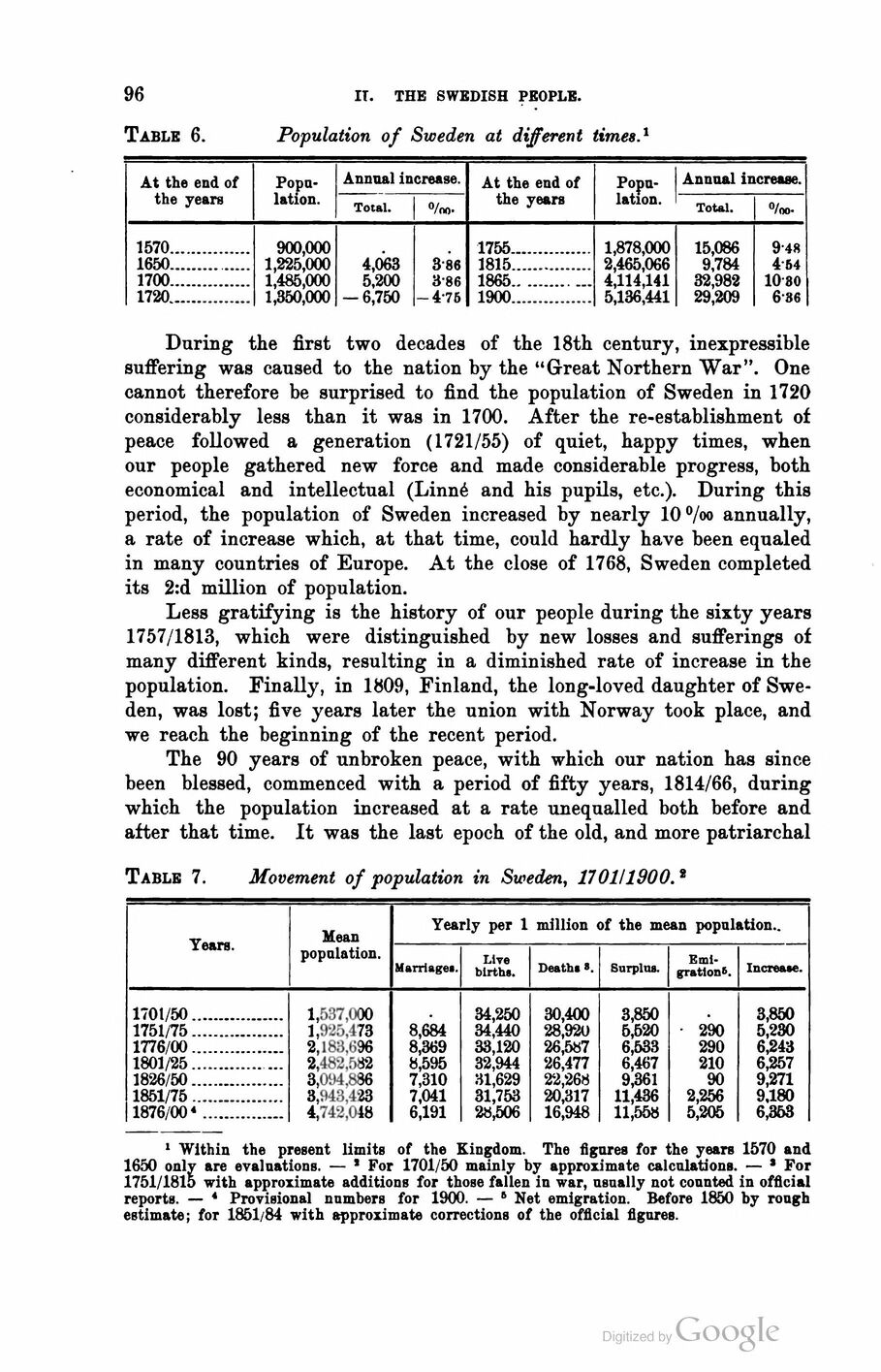
Full resolution (JPEG) - On this page / på denna sida - First part - II. The Swedish People - 2. Demography of Sweden - Population at different periods

<< prev. page << föreg. sida << >> nästa sida >> next page >>
Below is the raw OCR text
from the above scanned image.
Do you see an error? Proofread the page now!
Här nedan syns maskintolkade texten från faksimilbilden ovan.
Ser du något fel? Korrekturläs sidan nu!
This page has never been proofread. / Denna sida har aldrig korrekturlästs.
96 II. TH B SWEDISH PEOPLE.
Table 6. Population of Sweden at different times.1
At the end of the years [-Population.-] {+Popu- lation.+} Annual increase.
Total. %o.
1570............... 900,000
1650.............. 1,225,000 4,063 3’86
1700............... 1,485,000 5,200 3’86
1720............... 1,350,000 — 6,750 -4-75
1755..............................1,878,000 15,086 948
1815..............................2,465,066 9,784 4 54
1865................4,114,141 32,982 1080
1900..............................5,136,441 29,209 686
During the first two decades of the 18th century, inexpressible
suffering was caused to the nation by the "Great Northern "War". One
cannot therefore be surprised to find the population of Sweden in 1720
considerably less than it was in 1700. After the re-establishment of
peace followed a generation (1721/55) of quiet, happy times, when
our people gathered new force and made considerable progress, both
economical and intellectual (Linné and his pupils, etc.). During this
period, the population of Sweden increased by nearly 10 °/oo annually,
a rate of increase which, at that time, could hardly have been equaled
in many countries of Europe. At the close of 1768, Sweden completed
its 2:d million of population.
Less gratifying is the history of our people during the sixty years
1757/1813, which were distinguished by new losses and sufferings of
many different kinds, resulting in a diminished rate of increase in the
population. Finally, in 1809, Finland, the long-loved daughter of
Sweden, was lost; five years later the union with Norway took place, and
we reach the beginning of the recent period.
The 90 years of unbroken peace, with which our nation has since
been blessed, commenced with a period of fifty years, 1814/66, during
which the population increased at a rate unequalled both before and
after that time. It was the last epoch of the old, and more patriarchal
Table 7. Movement of population in Sweden, 1701/1900.8
Years. Mean population. Yearly per 1 million of the mean population..
Marriages. LITO births. Deaths ». Surplus. [-Emigration’.-] {+Emi- gration’.+} Increase.
1701/50................. 1,537,(100 34,250 30,400 3,850 3,850
1751/75................. 1,925,473 8,684 34,440 28,920 5,520 - 290 5,230
1776/00................. 2,183,H96 8,369 33,120 26,587 6,533 290 6,243
1801/25................ 2,482,582 8,595 32,944 26,477 6,467 210 6,257
1826/50 ................. 3,094.886 7,310 31,629 22,268 9,361 90 9,271
1851/75 ................. 3,943,423 7,041 31,753 20,317 11,436 2,256 9,180
1876/00 4 ............... 4,742,048 6,191 20,506 16,948 11,558 5,205 6,353
1 Within the present limits of the Kingdom. The figures for the years 1570 and
1650 only are evaluations. — 1 For 1701/50 mainly by approximate calculations. — ’ For
1751/1815 with approximate additiong for those fallen in war, usually not counted in official
reports. — * Provisional numbers for 1900. — s Net emigration. Before 1850 by rough
estimate; for 1851/84 with approximate corrections of the official figures.
<< prev. page << föreg. sida << >> nästa sida >> next page >>